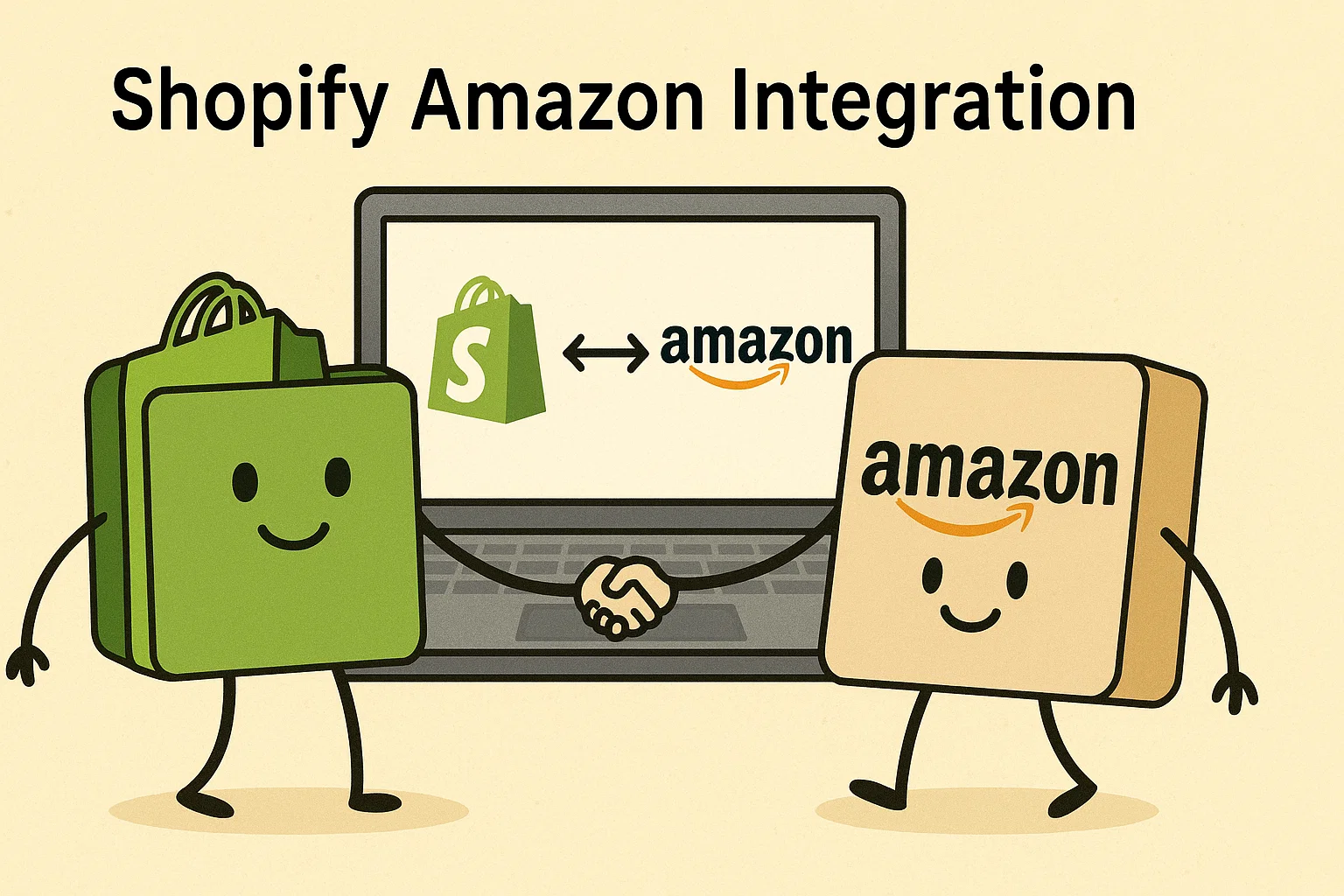In today’s rapidly evolving eCommerce landscape, selling on a single platform is no longer enough. Consumers shop across multiple marketplaces, and to keep up with the demand, smart online retailers are turning to multichannel selling strategies. One of the most powerful combinations available in 2025 is integrating your Shopify store with Amazon—the world’s largest online marketplace.
Whether you’re a Shopify seller looking to tap into Amazon’s massive customer base or an Amazon FBA seller wanting to build a standalone DTC (direct-to-consumer) brand via Shopify, Shopify Amazon integration opens up new opportunities for scale, automation, and revenue.
But integrating two giant platforms can feel overwhelming without the right guidance.
This comprehensive guide will walk you through everything you need to know about how to connect Shopify to Amazon, including requirements, benefits, common mistakes to avoid, and a step-by-step integration process. By the end, you’ll understand how to sell Amazon products on Shopify, manage orders efficiently, and use both platforms to grow your business faster and smarter.
Let’s dive in and unlock the potential of Shopify with Amazon in 2025.
How Do You Benefit from Shopify Amazon Integration?
In 2025, success in eCommerce depends heavily on how seamlessly your business operates across multiple channels. Integrating Shopify with Amazon gives you a distinct advantage by allowing you to tap into Amazon’s massive reach while retaining the brand control and customization power of your Shopify store.
Here are the biggest reasons why this integration is worth pursuing:
Reach Millions of New Customers on Amazon
Amazon is one of the largest online marketplaces in the world, with over 300 million active customer accounts. Integrating Shopify with Amazon lets you list your products on Amazon while continuing to manage everything from your Shopify dashboard.
You don’t need to build a new customer base — Amazon brings the traffic.
Centralized Inventory & Order Management
Instead of managing orders separately for Shopify and Amazon, integration allows for automated inventory syncing and centralized order fulfillment. This reduces manual work, prevents overselling, and improves operational efficiency.
You’ll avoid inventory errors and stock-outs, even during high-volume periods like Prime Day or Black Friday.
Increased Brand Exposure and Trust
Shopify helps you create a strong branded storefront, while Amazon provides third-party trust signals like customer reviews and fast shipping options. Together, they give your brand both visibility and credibility.
Selling on Amazon also gives access to programs like Amazon Prime, which improves conversion rates due to faster delivery and consumer trust.
Automated Fulfillment via FBA
If you’re already using Fulfilled by Amazon (FBA), integration allows Shopify orders to be fulfilled through your existing Amazon FBA inventory. This means your Shopify store can enjoy Prime-level shipping without added logistics complexity.
You can have Amazon handle all storage, packing, and shipping — even for orders that originate on Shopify.
Scale Faster with Less Manual Work
Automated syncing of pricing, inventory, and orders allows you to scale to more products and markets without increasing overhead. Instead of managing two entirely separate storefronts, integration simplifies the process into a single, cohesive workflow.
Diversify Risk and Revenue Streams
Relying on only one channel (Shopify or Amazon) makes your business vulnerable to platform-specific issues like algorithm changes, account suspensions, or ad costs. Selling on both channels spreads out that risk and ensures steady income.
Looking for reliable fulfillment after integrating Shopify with Amazon? Check out our guide on the Top 10 Best 3PL for Shopify to streamline your logistics.
Requirements for Shopify Amazon Integration
Before diving into integrating Shopify with Amazon, it’s important to understand the key requirements you’ll need to meet for a smooth setup. Whether you’re a new seller or expanding to Amazon, these prerequisites ensure that the process is both compliant and technically feasible.
Here’s what you need:
A Shopify Store (Active & Functional)
To begin, you must have an active Shopify store with:
A paid Shopify plan (Basic, Shopify, or Advanced — trial plans won’t work for integration)
At least one published product that complies with Amazon’s product guidelines
Proper product categories, descriptions, and high-quality images
Your Shopify store will serve as your base for syncing product listings to Amazon.
An Amazon Professional Seller Account
Amazon requires a Professional Seller Account (not an Individual account) to connect with external platforms like Shopify. This account costs $39.99/month and offers:
Access to bulk listing tools
Buy Box eligibility
Integration permissions via Amazon Marketplace Web Service (MWS) or SP-API
If you don’t already have one, you can sign up at sellercentral.amazon.com.
Compliance with Amazon Product Guidelines
Amazon has strict policies and standards around product listings. To successfully integrate and avoid listing rejections, your products must:
Fall under an approved category (some categories require pre-approval)
Meet listing quality requirements (images, descriptions, and attributes)
Comply with regional laws (especially for food, health, or electronics)
Not violate trademark or brand guidelines
Also, ensure UPCs or GTINs are in place, as Amazon often requires product identifiers for catalog matching.
Amazon Marketplaces Linked to Shopify
Currently, Shopify allows integration with Amazon marketplaces in select countries (primarily Amazon.com in the U.S.). If you’re selling in the U.S. market, you’re good to go.
If you plan to sell on other Amazon marketplaces (like UK, CA, AU, etc.), check if Shopify’s Amazon sales channel or third-party apps support your region.
Currency & Tax Settings
Amazon transactions will typically be processed in USD for U.S. marketplaces, while Shopify allows sales in multiple currencies. You’ll need to configure:
Currency matching between Shopify and Amazon
Tax collection settings (sales tax, VAT, etc.)
Shipping rates that align across both platforms
Having this aligned ensures there are no pricing inconsistencies or order sync errors.
A Reputable Fulfillment Plan (FBA or FBM)
You’ll need to decide how you’ll fulfill Amazon orders:
Fulfilled by Merchant (FBM): You pack and ship products directly from your warehouse or through third-party logistics (3PL).
Fulfilled by Amazon (FBA): You send your inventory to Amazon’s warehouses, and Amazon handles storage, shipping, and returns.
Shopify integrates well with both, but FBA users will benefit from Amazon Prime and faster delivery windows.
Install the Amazon Sales Channel App (or Integration App)
In your Shopify dashboard:
Go to the Shopify App Store
Search for the Amazon Sales Channel
Install the app and follow the prompts to connect your Amazon account
Just getting started with Shopify? Don’t miss our full guide: Shopify 3 Months for $1: – the perfect way to launch affordably and risk-free!
How to Integrate Your Shopify Store with Amazon?
Seamlessly integrating your Shopify store with Amazon can significantly expand your customer reach and sales potential. Here’s a comprehensive, easy-to-follow guide to help you successfully connect your Shopify store with Amazon in 2025.
Set Up a Professional Amazon Seller Account
Before integrating, you need to create an Amazon Professional Seller Account, which is mandatory for integration.
Here’s how:
Visit Amazon Seller Central.
Click “Sign up” and choose to create a new seller account.
Fill out the required details:
Business name and address
Phone number
Valid bank account and credit card
Store name
Taxpayer Identification Number (TIN)
The Professional Seller plan costs $39.99/month and gives access to advanced tools, bulk listings, advertising features, and the Buy Box.
Get Approval for Restricted Categories (If Needed)
Not all product categories are open. Some require Amazon’s prior approval before you list items.
To check and request approval:
Go to Amazon’s “Categories and Products that Require Approval” section.
Find your product category and see if it requires approval.
If yes, click “Request Approval” and submit necessary documentation.
If no, proceed to the next step.
Failure to get category approval can lead to listing removals or account issues.
Prepare and Optimize Your Shopify Store
A well-optimized Shopify store sets the foundation for a successful Amazon integration.
Do the following:
Ensure your store design is professional and your website is live.
Optimize product listings with:
Clear titles and descriptions
High-quality images
Keywords for SEO
Ensure product pages are complete and accurate.
Verify product availability and inventory levels.
Choose an Amazon Integration App
Shopify no longer supports the native Amazon Sales Channel. Instead, use a third-party integration app from the Shopify App Store.
Recommended apps include:
Codisto Amazon by Shopify
CedCommerce Amazon Channel
To install:
Go to your Shopify admin panel → Apps → Shopify App Store
Search for “Amazon integration”
Choose an app and click “Add App”
Connect Your Shopify Store to Amazon
Once the app is installed:
Open the app and click “Connect Seller Account”
Log into your Amazon Seller Central account
Authorize the app to manage your listings, inventory, and orders
This connection allows the app to sync product and order data between Amazon and Shopify.
Create or Link Amazon Listings
You now need to either create new Amazon listings using Shopify product data or link to existing Amazon listings.
Option A: Create New Listings
Choose the products you want to list
Map to the correct Amazon category
Add product title, description, bullet points, and images
Enter required identifiers (UPC, EAN, or ASIN)
Option B: Link Existing Listings
Select products in the app
Search and link them to existing ASINs on Amazon
Match SKUs from Shopify with Amazon listings
Ensure listings follow Amazon’s product guidelines and content policies.
Configure Fulfillment Settings
Determine how you will fulfill your Amazon orders.
You have two options:
FBA (Fulfilled by Amazon) – Amazon handles storage, packing, and shipping
FBM (Fulfilled by Merchant) – You handle order fulfillment directly
In your app:
Go to Fulfillment Settings
Select either FBA or FBM for each product
FBA typically offers faster shipping and improves Buy Box chances. FBM gives more control and branding opportunities.
Sync Inventory Between Platforms
Enable real-time inventory syncing to prevent overselling or stockouts.
Activate Inventory Sync within your integration app
Choose how frequently inventory updates (real-time recommended)
Ensure all inventory is properly matched between Shopify and Amazon
Inventory levels will automatically adjust based on sales made on either platform.
Enable Order Syncing and Manage Fulfillment
Sync Amazon orders directly to Shopify for unified order management.
Enable Order Syncing in the app’s settings
Orders placed on Amazon will show up in Shopify, including customer and shipping details
Fulfill Orders Based on Model:
FBA: The order is sent to Amazon automatically. No action needed.
FBM: You fulfill through Shopify, generate a label, and ship via your carrier.
Tracking info is updated on both platforms and shared with the customer.
Monitor and Optimize Your Integration
Once the integration is live, performance monitoring is key.
Regularly check:
Listing errors or syncing issues
Inventory mismatches
Buy Box eligibility
Shipping times and reviews
Use insights from the integration app to refine pricing, inventory strategies, and product listings. Tools like repricers or Amazon analytics plugins can help.
Common Challenges and How to Fix Them
Even with the right setup, integrating your Shopify store with Amazon isn’t always smooth sailing. Here are some of the most common challenges sellers face — along with practical solutions to resolve them:
Listing Sync Issues
Problem: Product data doesn’t sync properly between Shopify and Amazon — leading to missing listings, incorrect pricing, or inventory mismatches.
Fix:
Double-check that SKU numbers match between platforms.
Ensure your integration app settings are configured to sync all necessary fields (titles, prices, inventory).
Use bulk edit tools or contact app support to manually sync stuck listings.
Keep product data clean and Amazon-compliant (titles, descriptions, and images).
Inventory Not Updating in Real-Time
Problem: You sell a product on Amazon, but Shopify doesn’t update inventory quickly enough — or vice versa — resulting in overselling.
Fix:
Make sure real-time inventory sync is enabled in your integration app.
Avoid manual inventory updates that override the sync.
Set up low-stock alerts and safety stock buffers to prevent stockouts.
Orders Not Syncing to Shopify
Problem: Amazon orders are not appearing in your Shopify dashboard.
Fix:
Go to your integration app’s settings and ensure order syncing is turned on.
Check for errors in Amazon Seller Central or your integration dashboard.
Confirm your Amazon account is still connected and has necessary permissions.
Try refreshing the connection or reauthenticating your Amazon credentials.
Category or Product Listing Restrictions
Problem: Amazon won’t allow certain products to be listed due to restrictions or gating in specific categories.
Fix:
Review Amazon’s restricted categories and products before listing.
Submit a category approval request with supporting documentation.
If the restriction persists, consider alternative product categories or variations.
Conflicts Between FBA and FBM Listings
Problem: You’ve listed the same product as both Fulfilled by Amazon (FBA) and Fulfilled by Merchant (FBM), causing duplication or confusion.
Fix:
Choose one fulfillment method per product on Amazon for clarity.
If using both, set clear inventory levels and fulfillment rules in your app.
Monitor which listing is winning the Buy Box and adjust strategy accordingly.
Poor Buy Box Performance
Problem: Your products are not eligible or frequently lose the Buy Box on Amazon.
Fix:
Ensure competitive pricing and fast fulfillment (preferably via FBA).
Maintain excellent seller performance metrics (shipping times, order defect rate, customer satisfaction).
Use automated repricing tools to stay competitive without hurting profit margins.
Integration App Limitations
Problem: Some apps might not support all product types, advanced pricing rules, or fulfillment workflows.
Fix:
Evaluate top-rated apps like CedCommerce, Codisto, or Amazon by WebBee for feature compatibility.
Read app reviews or reach out to support before committing.
If needed, hire a Shopify/Amazon expert to customize the integration.
By proactively addressing these challenges, you can maintain a stable, scalable integration that drives multi-channel growth. Still facing persistent issues? It may be worth consulting with an Amazon integration specialist or support team from your chosen app.
Need more visitors to your Shopify store? Check out our actionable guide: How to Drive Traffic to Shopify Store 2025: Proven Strategies to start attracting high-converting traffic today!
How to Manage Orders and Inventory After Integration
Successfully integrating Shopify with Amazon is only the beginning — the real value comes from how efficiently you manage your operations post-integration. Without proper order and inventory management, even the best integration can lead to costly overselling, delayed shipments, and frustrated customers.
Here’s how to keep your multichannel business running like clockwork once your Shopify and Amazon systems are connected.
Unify Your Order Management Process
One of the biggest advantages of Shopify Amazon integration is centralized order management. Instead of toggling between platforms, your integration app funnels Amazon orders directly into your Shopify dashboard, allowing you to manage all sales from a single source of truth.
Real-time order sync ensures every Amazon order — including customer info, shipping method, and purchased items — is automatically reflected within Shopify.
You can view, process, and fulfill orders from both channels in one place, reducing manual tasks and minimizing fulfillment errors.
This unified workflow not only improves operational efficiency but also allows your team to deliver a faster, more consistent customer experience.
Enable Real-Time Inventory Synchronization
Overselling is one of the most common issues faced by sellers operating on multiple platforms — and the fastest way to hurt your Amazon seller performance. Thankfully, modern integration apps offer real-time inventory syncing between Shopify and Amazon.
To manage inventory effectively:
Ensure product SKUs are mapped correctly between both platforms.
Activate automated inventory updates to reflect sales, returns, and stock changes instantly.
Implement safety stock thresholds to account for sudden spikes in demand, especially during seasonal sales or flash promotions.
By maintaining synchronized inventory, you’ll prevent stockouts, reduce refund requests, and protect your seller reputation on both channels.
Choose and Configure the Right Fulfillment Model
Post-integration, your fulfillment strategy becomes even more critical. Depending on your business model, you can choose between:
Fulfilled by Amazon (FBA)
When using Amazon FBA, your Shopify store can tap into Amazon’s fulfillment network via Multi-Channel Fulfillment (MCF). That means:
Orders from Amazon and Shopify can be fulfilled using the same FBA inventory.
Shipping, tracking, and customer notifications are automatically handled by Amazon.
You can offer Prime-level logistics on your Shopify store — without building your own fulfillment infrastructure.
This is ideal for scaling rapidly without increasing overhead.
Fulfilled by Merchant (FBM)
If you prefer more control over branding, packaging, or logistics, FBM allows you to fulfill orders in-house or via a third-party logistics partner:
Orders appear in your Shopify dashboard and are processed using your custom workflows.
Tracking information is synced automatically back to Amazon, ensuring compliance with its shipping standards.
Offers flexibility for personalized customer experiences and niche product handling.
Choose the model that aligns best with your logistics capacity and brand goals — or use a hybrid approach for maximum flexibility.
Streamline Returns and Customer Support
Multichannel selling means more touchpoints — and more complexity when it comes to returns and customer service. A clear process ensures your support experience remains consistent.
Amazon orders must follow Amazon’s return policies and be processed via Seller Central, including return labels and timelines.
Shopify orders remain under your control, allowing you to offer more personalized policies and direct communication with customers.
Ensure your support team is trained to recognize the order source and respond according to the correct platform protocols.
Monitor Performance and Optimize Continuously
Integration isn’t a set-it-and-forget-it process — ongoing optimization is key to maximizing results. Most third-party apps provide advanced dashboards to help you monitor:
Inventory turnover across channels
Order fulfillment rates and lag times
SKU-level performance
Buy Box win rates and pricing competitiveness
Use this data to make informed decisions, such as reallocating stock, adjusting pricing strategies, or expanding into new product lines. Integrating Shopify with Amazon gives you the infrastructure to scale, but consistent monitoring ensures you actually do.
💳 Confused about payment processing on Shopify? Learn how Shopify Payments works and how it can streamline your checkout process in our full guide: What is Shopify Payments?
Conclusion
Integrating Shopify with Amazon in 2025 is no longer just a competitive advantage—it’s a necessity for serious eCommerce sellers. By combining Shopify’s flexible storefront design with Amazon’s massive reach and logistics capabilities, you can scale faster, manage operations more efficiently, and diversify your sales channels like a pro.
Whether you’re an established brand or just starting, this integration opens up new avenues for growth, customer acquisition, and streamlined order fulfillment. Just make sure to choose the right integration app, stay compliant with Amazon’s policies, and regularly monitor your performance.
With the right setup, Shopify Amazon integration becomes the engine behind a powerful multichannel selling strategy.
Thinking about dropshipping? Discover how to seamlessly source and sell products using AliExpress with our step-by-step guide: Dropshipping From AliExpress To Shopify In 2025.
FAQs
Can I integrate Shopify with Amazon?
Yes, you can integrate Shopify with Amazon using third-party apps like CedCommerce Amazon Channel, Amazon by Codisto, or Amazon Integration Plus, as Shopify discontinued its native Amazon sales channel in 2021. These apps allow you to sync inventory, manage orders, and list products on Amazon directly from your Shopify admin.
How can I sell on Amazon with Shopify?
To sell on Amazon with Shopify, follow these steps:
Create an Amazon Professional Seller account.
Check for category approval if required.
Install a compatible Amazon integration app on Shopify.
Connect your Amazon account.
Sync your product listings, manage inventory, and configure fulfillment (FBA or FBM).
Once set up, your Shopify products will be live on Amazon, and you can manage everything from your Shopify dashboard.
Can I use Amazon FBA with Shopify?
Yes, you can use Amazon FBA (Fulfilled by Amazon) with your Shopify store. When a customer places an order (whether from Shopify or Amazon), the integration app can automatically route the order to Amazon for fulfillment. This allows you to leverage Amazon’s warehousing, packing, and shipping capabilities while still selling through your Shopify storefront.
Contact Us for Tailored Solutions – Stores Automation
Ready to transform your Shopify store and achieve big wins? Contact us at Stores Automation for personalized solutions that leverage the power of automation for your business. Reach out to us at 302-204-8244 or via email at info@storesautomation.com. For more information, visit our Sign Up page. Embark on the path to e-commerce success with Stores Automation – where small changes lead to big win.





